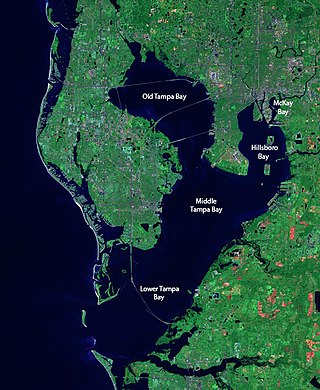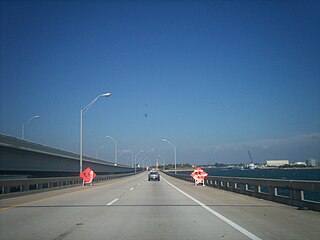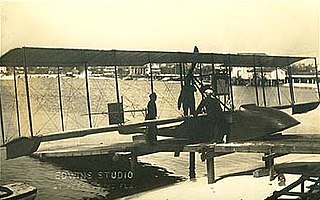
Pinellas County is a county located on the west central coast of the U.S. state of Florida. As of the 2020 census, the population was 959,107, making it the seventh-most populous county in the state. It is also the most densely populated county in Florida, with 3,491 residents per square mile. The county is part of the Tampa–St. Petersburg–Clearwater Metropolitan Statistical Area. Clearwater is the county seat. St. Petersburg is the largest city in the county, as well as the largest city in Florida that is not a county seat.

St. Petersburg is a city in Pinellas County, Florida, United States. As of the 2020 census, the population was 258,308, making it the fifth-most populous city in Florida and the most populous city in the state that is not a county seat. It is the second-most populous city in the Tampa Bay area, which is the second-largest metropolitan area in Florida with a population of around 2.8 million.

Tampa Bay is a large natural harbor and shallow estuary connected to the Gulf of Mexico on the west-central coast of Florida, comprising Hillsborough Bay, McKay Bay, Old Tampa Bay, Middle Tampa Bay, and Lower Tampa Bay. The largest freshwater inflow into the bay is the Hillsborough River, which flows into Hillsborough Bay in downtown Tampa. Many other smaller rivers and streams also flow into Tampa Bay, resulting in a large watershed area.

Hamilton Disston was an industrialist and real-estate developer who purchased 4 million acres (16,000 km²) of Florida land in 1881, an area larger than the state of Connecticut, and reportedly the most land ever purchased by a single person in world history. Disston was the son of Pennsylvania-based industrialist Henry Disston who formed Disston & Sons Saw Works, which Hamilton later ran and which was one of the largest saw manufacturing companies in the world.

Antony Habersack Jannus, more familiarly known as Tony Jannus, was an early American pilot whose aerial exploits were widely publicized in aviation's pre-World War I period. He flew the first airplane from which a parachute jump was made, in 1912. Jannus was also the first airline pilot, having pioneered the inaugural flight of the St. Petersburg–Tampa Airboat Line on January 1, 1914, the first scheduled commercial airline flight in the world using heavier-than-air aircraft. The Tony Jannus Award, created to perpetuate his legacy, recognizes outstanding individual achievement in the scheduled commercial aviation industry and is conferred annually by the Tony Jannus Distinguished Aviation Society founded in Tampa, Florida, in 1963.

Peter Demens, born Pyotr Alexeyevitch Dementyev, was a Russian nobleman who migrated in 1881 to the United States and became a railway owner and one of the founders of St. Petersburg, Florida, United States.
The modern history of Tampa, Florida, can be traced to the founding of Fort Brooke at the mouth of the Hillsborough River in today's downtown in 1824, soon after the United States had taken possession of Florida from Spain. The outpost brought a small population of civilians to the area, and the town of Tampa was first incorporated in 1855.

Timeline of Pinellas County, Florida history.

Albert Whitted Airport is a public airport in St. Petersburg, Pinellas County, Florida, United States. It is on the west edge of Tampa Bay, just southeast of downtown St. Petersburg and east of the University of South Florida St. Petersburg.

The Benoist XIV, also called The Lark of Duluth, was a small biplane flying boat built in the United States in 1913 in the hope of using it to carry paying passengers. The two examples built were used to provide the first heavier-than-air airline service anywhere in the world, and the first airline service of any kind at all in the United States.

Jannus Live is an outdoor music venue in St. Petersburg, Florida. Located in the Downtown St. Petersburg Historic District, the courtyard venue has hosted numerous concerts for local and mainstream artists. The venue was founded in 1984 by Bob Barnes & Bill Pendergast & Gene Bryant and was named after pilot, Tony Jannus. In 2009, the venue was renovated and opened later in March 2010 under a new owner Jeff Knight "Jannus Live" and management. The venue is cited for hosting the most concerts in the Bay Area. In 2010, the venue was awarded "Best Small Concert Venue" and "Best Back in the Saddle" from the Creative Loafing Best of Bay Awards. This venue is known for having outdoor standing room only. No outside seating is permitted to enter the venue.
Transportation in Florida includes a variety of options, including Interstate Highways, U.S. Highways, and Florida State Roads; Amtrak and commuter rail services; airports, public transportation, and sea ports, in a number of the state's counties and regions.

Frank Allston Davis was a publishing executive who founded the F. A. Davis Company in Philadelphia, Pennsylvania. After moving to the Tampa Bay Area, he introduced electricity to St. Petersburg, Florida, and founded the city of Pinellas Park.

George Sheppard "Dad" Gandy was an American business executive and developer, best known for constructing the original Gandy Bridge, the first bridge to span the Tampa Bay in Florida. He is also known for developing numerous buildings and transportation lines in Philadelphia and St. Petersburg, Florida.

The Episcopal Diocese of Southwest Florida is a diocese of the Episcopal Church in the United States of America (ECUSA) in Florida which extends from Marco Island on the south, to Brooksville on the north, and inland to Plant City, Arcadia and LaBelle on the east. As part of the ECUSA, the diocese is a constituent member of the worldwide Anglican Communion.

The St. Petersburg–Tampa Airboat Line was the first scheduled airline using a fixed wing aircraft. The airline provided service between St. Petersburg, Florida and neighboring Tampa across Tampa Bay, a distance of about 23 miles. It was in service from January to May 1914.
Edwin Hyde Tomlinson was a world traveler, and an early benefactor of St. Petersburg, Florida in the United States, best known for his many gifts to the city and its inhabitants. Tomlinson built the city's first brick school, constructed a 2,500-seat auditorium, donated the land for the first electrical plant, constructed St. Peter's Episcopal Church, and helped develop the city's first hospital and open-air post office. His most well known attraction in St. Petersburg was the Fountain of Youth.
John Constantine Williams, Sr. was the cofounder of St. Petersburg, Florida, with Captain Peter Demens. Williams Park is named for him.
The Orange Belt Railway was a 3 ft narrow gauge railroad established in 1885 by Russian exile Peter Demens in Florida. It was one of the longest narrow gauge railroads in the United States at the time of its completion in 1888, with a mainline 152 miles (245 km) in length between Sanford and St. Petersburg. It carried citrus, vegetables, and passengers; and it interchanged with two standard gauge lines: the Jacksonville, Tampa and Key West Railway at Lake Monroe, and the Florida Central and Peninsular Railroad at Lacoochee.
The following is a timeline of the history of the city of St. Petersburg in Pinellas County, Florida, United States.
















